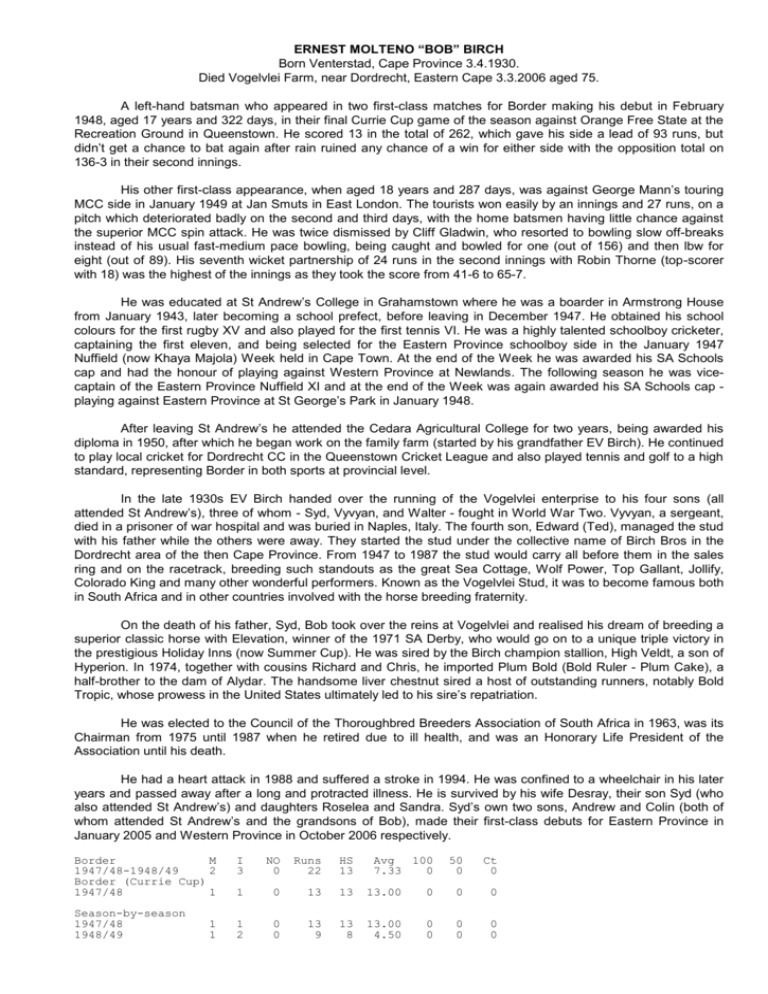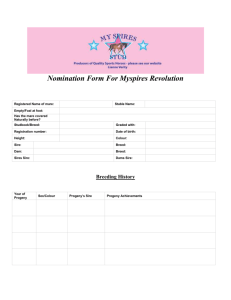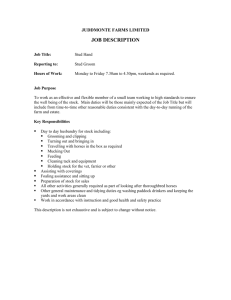OBITUARIES
advertisement

ERNEST MOLTENO “BOB” BIRCH Born Venterstad, Cape Province 3.4.1930. Died Vogelvlei Farm, near Dordrecht, Eastern Cape 3.3.2006 aged 75. A left-hand batsman who appeared in two first-class matches for Border making his debut in February 1948, aged 17 years and 322 days, in their final Currie Cup game of the season against Orange Free State at the Recreation Ground in Queenstown. He scored 13 in the total of 262, which gave his side a lead of 93 runs, but didn’t get a chance to bat again after rain ruined any chance of a win for either side with the opposition total on 136-3 in their second innings. His other first-class appearance, when aged 18 years and 287 days, was against George Mann’s touring MCC side in January 1949 at Jan Smuts in East London. The tourists won easily by an innings and 27 runs, on a pitch which deteriorated badly on the second and third days, with the home batsmen having little chance against the superior MCC spin attack. He was twice dismissed by Cliff Gladwin, who resorted to bowling slow off-breaks instead of his usual fast-medium pace bowling, being caught and bowled for one (out of 156) and then lbw for eight (out of 89). His seventh wicket partnership of 24 runs in the second innings with Robin Thorne (top-scorer with 18) was the highest of the innings as they took the score from 41-6 to 65-7. He was educated at St Andrew’s College in Grahamstown where he was a boarder in Armstrong House from January 1943, later becoming a school prefect, before leaving in December 1947. He obtained his school colours for the first rugby XV and also played for the first tennis VI. He was a highly talented schoolboy cricketer, captaining the first eleven, and being selected for the Eastern Province schoolboy side in the January 1947 Nuffield (now Khaya Majola) Week held in Cape Town. At the end of the Week he was awarded his SA Schools cap and had the honour of playing against Western Province at Newlands. The following season he was vicecaptain of the Eastern Province Nuffield XI and at the end of the Week was again awarded his SA Schools cap playing against Eastern Province at St George’s Park in January 1948. After leaving St Andrew’s he attended the Cedara Agricultural College for two years, being awarded his diploma in 1950, after which he began work on the family farm (started by his grandfather EV Birch). He continued to play local cricket for Dordrecht CC in the Queenstown Cricket League and also played tennis and golf to a high standard, representing Border in both sports at provincial level. In the late 1930s EV Birch handed over the running of the Vogelvlei enterprise to his four sons (all attended St Andrew’s), three of whom - Syd, Vyvyan, and Walter - fought in World War Two. Vyvyan, a sergeant, died in a prisoner of war hospital and was buried in Naples, Italy. The fourth son, Edward (Ted), managed the stud with his father while the others were away. They started the stud under the collective name of Birch Bros in the Dordrecht area of the then Cape Province. From 1947 to 1987 the stud would carry all before them in the sales ring and on the racetrack, breeding such standouts as the great Sea Cottage, Wolf Power, Top Gallant, Jollify, Colorado King and many other wonderful performers. Known as the Vogelvlei Stud, it was to become famous both in South Africa and in other countries involved with the horse breeding fraternity. On the death of his father, Syd, Bob took over the reins at Vogelvlei and realised his dream of breeding a superior classic horse with Elevation, winner of the 1971 SA Derby, who would go on to a unique triple victory in the prestigious Holiday Inns (now Summer Cup). He was sired by the Birch champion stallion, High Veldt, a son of Hyperion. In 1974, together with cousins Richard and Chris, he imported Plum Bold (Bold Ruler - Plum Cake), a half-brother to the dam of Alydar. The handsome liver chestnut sired a host of outstanding runners, notably Bold Tropic, whose prowess in the United States ultimately led to his sire’s repatriation. He was elected to the Council of the Thoroughbred Breeders Association of South Africa in 1963, was its Chairman from 1975 until 1987 when he retired due to ill health, and was an Honorary Life President of the Association until his death. He had a heart attack in 1988 and suffered a stroke in 1994. He was confined to a wheelchair in his later years and passed away after a long and protracted illness. He is survived by his wife Desray, their son Syd (who also attended St Andrew’s) and daughters Roselea and Sandra. Syd’s own two sons, Andrew and Colin (both of whom attended St Andrew’s and the grandsons of Bob), made their first-class debuts for Eastern Province in January 2005 and Western Province in October 2006 respectively. Border M 1947/48-1948/49 2 Border (Currie Cup) 1947/48 1 Season-by-season 1947/48 1948/49 1 1 I 3 NO 0 Runs 22 HS 13 Avg 100 7.33 0 1 0 13 13 13.00 1 2 0 0 13 9 13 8 13.00 4.50 50 0 Ct 0 0 0 0 0 0 0 0 0 0 History of the Vogelvlei Stud: The Vogelvlei Stud of EV Birch, located at Dordrecht, was to largely dominate South African breeding between 1940 and the 1980s. Dordrecht lies at an altitude of 6000 feet in grassland country on the slopes of the Drakensberg range, South Africa's equivalent of the United States' 'Great Divide.' In winter, the days are cool with freezing nights and regular snow falls. Vogelvlei lies in a valley of many thousands of acres. Mares and foals run in huge paddocks of natural and planted grasses on which sheep also graze. EV Birch came to South Africa from Yorkshire as a young man and married the daughter of a district pioneer. He initially bred draught horses, but after World War One shifted to breeding thoroughbreds. He went to England where he purchased a few stallions and about thirty mares. His stud had moderate success with the White Eagle son, Bird of Prey, and then the Buchan son, Cockpen, a brilliant two-year old in England that he imported in 1933 who became a good sire in the late 1930s and early 1940s, placing second on the sire's list to Sunstone in 1942. But it wasn't until Sir Abe Bailey (the very same Abe Bailey who was involved in the early history of South African cricket), began scaling down his breeding stud in the last years before his death in 1940, passed on some valuable breeding stock to his friend, Birch, that Vogelvlei rose to its dominant position. Among the horses EV Birch acquired from Bailey was the imported Sunstone, already twice leading sire for Bailey's Clewer Stud. Beginning in 1940, Sunstone became leading sire again, for three successive years, all posthumously, since his last crop were foals of 1939. One of these foals was Lenin, out of the imported mare Drohsky, who was sold as a yearling to M Lipschitz. Lenin was generally held to be the best racehorse produced in South Africa to 1944, the year he retired from the turf, the winner of 18 races, placing second six times in a five year career that netted him winnings of £15,943 a record to that time. In the late 1930s EV Birch handed over the running of the Vogelvlei enterprise to his four sons, three of whom - Syd, Vyvyan, and Walter - fought in World War Two. Vyvyan, a sergeant, died in a POW hospital and was buried in Naples, Italy. The fourth son, Edward (Ted), managed the stud with his father while the others were away. Vogelvlei Stud's Fairthorn led the sire's list five times; his best running son was Sea Cottage. Sea Cottage had great speed and class, winning a record R117,037 including the Cape Derby and most of the principal handicaps. In 1939 the very well-performed French-bred Asbestos II (1932), by Asterus, was purchased from the great Cape Town trainer Syd Garrett, who had purchased him from Lord Derby. Asbestos had won the Cape Metropolitan Handicap in 1937 and had placed second in the Durban July. At Vogelvlei he was an immediate stud success and from 1945 he was champion sire for six successive years, though unfortunately he died prematurely in 1944. His blood through female lines continued in many Birch-bred champions, such as Sea Cottage, Colorado King, and Wolf Power, the latter two at stud in the United States. After World War Two, three Birch sons - Sydney, Ted and Walter - each assumed control of a separate farm, all of which operated under the Vogelvlei Stud name, with a total of about 120 mares. They imported a succession of high-class stallions that became champion sires: Fairthorn (by Fair Trial), Ranjit (by Fairway), Herculaneum (by Donatello), High Veldt (by Hyperion), New South Wales (by Abernant), and Plum Bold (by Bold Ruler). In addition, South African-bred Elevation (1968), by their champion sire High Veldt, won the South African Derby in 1972, and became Vogelvlei's champion sire in 1984, the only South African-bred horse besides the Greatorex son, Dignitary (1918), ever to occupy that position. Another stallion at Vogelvlei was Merchant Navy (by Hyperion - Rose of England), who was a good broodmare sire, and was damsire of the great racehorse Sea Cottage (1962, by Fairthorn), bred by the Birch brothers; Sea Cottage's female line was strict Vogelvlei breeding for several generations, going back to Drohsky, the dam of the 1944 champion racehorse, Lenin. Other good sires at Vogelvlei included Djask (Tourbillon - Loika), Turbulent (by Indus), Olina (by Solario) and Grand Rapids (by Macherio), the latter also a distinguished broodmare sire. As a result of import difficulties during the Second World War and pressure from local breeders after it, in 1950 the government placed a ban on horses imported for racing purposes. There was also, for economic reasons, a limit on the amount that could be spent annually on imported breeding stock. This policy continued until the early 1970s when imported yearlings, in particular fillies, could be imported for racing prior to going to stud. These came from Australia, New Zealand and the Argentine, where horses were bred to the Southern hemisphere season. They were later allowed to compete in the local classics, and later still, the restriction on imported mares and stallions for racing was lifted, provided that they were imported for eventual stud purposes. No geldings were, or are permitted to be imported. After the relaxation of import regulations, a number of mares and fillies from Australia, New Zealand, Argentina and the Northern Hemisphere were brought into the country, broadening the bloodline base in the distaff population. 1954 saw the last imported feature race winner when Coquimbo (by Montrose) won the two mile Durban Gold Cup. For the next twenty years, no overseas-bred horse won a major race until 1975 when New Zealand- bred Sledgehammer, imported as a yearling, won the ten furlong Cape Metropolitan. Since the 1950s, South African-bred horses have won almost all stakes races. Beginning in the 1970s handicap stakes races were replaced by either weight-for-age races, or a handicap system based on age, earnings and performance over the distance. Now, as in other countries, the greatest percentage of races are of sprint distances up to a mile. The major stakes races are ten furlongs, with very few races of staying distances. The Gold Cup in Durban over 2 miles is the richest of the latter. The wool boom of the 1950s brought many sheep farmers into horse breeding, some of whom stocked their stud farms with huge dispersal of Nourse's Dwarsvlei Stud. In the 1980s, the Birch breeding empire, then in its fourth generation, began to scale back. Towards the latter part of the century, South African breeding reflected world-wide trends, with newcomers whose main source of income was in industry, not farming. The latter decades of the 20th century saw the rise of large breeding syndicates, represented by such horses as six-time leading sire Persian Wonder (by Persian Gulf) and five-time leading sire Jungle Cove (by Bold Ruler), both at the successful Highlands Stud, and Foveros (by Averof), an eight-time leading sire who stood at the Scott Brothers Stud. Other recent breeding enterprises with champion stallions include Paul de Wet's Zandvliet Stud (Noble Chieftain by Nearco - three times leading sire), the Oppenheimer’s Mauritzfontein Stud (Wilwyn by Pink Flower and Fort Wood by Sadler's Wells) and Granville Gorton's Noreen Stud (Drum Beat by Fair Trial). Starting in the late '70s, breeders began to look towards North America for stallions: Vogelvlei's Bold Ruler son, Plum Bold, was a successful sire, leading the list in 1980 (he was repatriated to the United States), and Highlands Stud's Jungle Cove, another Bold Ruler son dominated the list in the first half of the '80s. Since then, six other stallions imported from the U.S. have risen to the top of the stallion ranks.





